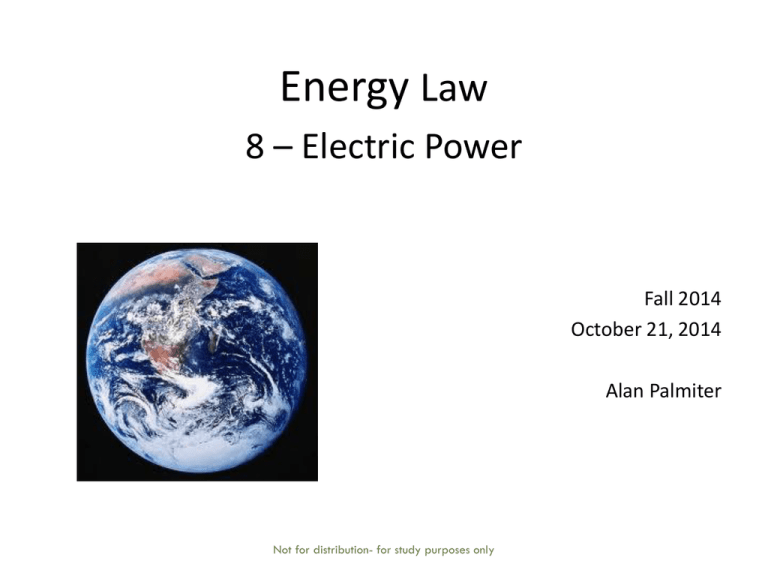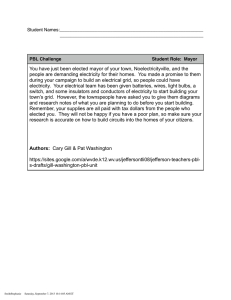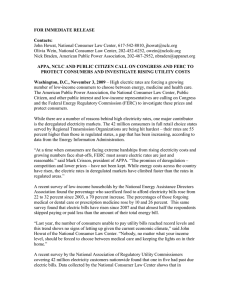Energy Law 8 – Electric Power Fall 2014
advertisement

Energy Law 8 – Electric Power Fall 2014 October 21, 2014 Alan Palmiter Not for distribution- for study purposes only Topic roadmap 1. Electric power sector – History of electricity – How “the grid” works 2. Generation, transmission and consumption of electricity – Traditional / renewable generation – Transmission of electricity – Electricity distribution 3. Regulation - electric power system – – – – Generation (state v. federal jurisdiction) Transmission Distribution Public utility regulation and deregulation 4. Future of electric power system – Regulatory coordination – “The smart grid” 1. The electric power sector http://www.eia.gov/totalenergy/data/annual/pecss_diagram.cfm Electricity - timeline 1600 1850 1875 1900 2000 How the Modern Grid Works (Click for video – 3.47 ) Pop Quiz Electric power system 1. True or false? Most electric power in the United States is generated from natural gas. 2. Which is true – a. Electricity can be stored by power plants for later use. b. Distribution and long-distance transmission lines operate at the same voltage. c. A home uses electricity at a higher voltage than the voltage used for transmission. d. Electricity must pass through a transformer to go from long-distance transmission to distribution lines. 3. Which is false a. The majority of electricity today comes from a thermal power plant of some type. b. Only negligible electricity is lost during transmission. c. The majority of electricity today is generated from a steam engine of some type. d. Power supply must be continuously matched with power demand. 4. The second industrial revolution was made possible by the expanded use of electricity. Answers: 1-F / 2-d / 3-b / 4-T 2. Generation, transmission, consumption of electricity Traditional generation • • • Fueled by coal, oil, natural gas or uranium Fuels transported to power plant Conversion occurs after transport of primary inputs to power plant Renewable generation • • • Fueled by wind, solar or hydro Conversion occurs at point of resource collection Electricity itself is transported The distinction http://www.eia.gov/totalenergy/data/annual/pecss_diagram.cfm Transmission of electricity The United States power transmission grid consists of 300,000 km of lines operated by 500 companies. Source: Wikipedia Transmission of electricity Source: ERCOT, Link Transmission Operators Source: ISO/RTO Council, Link Distribution of electricity Source: Unitil, click here Centralized power generation Pros: Cons: Economics of scale. Minimal number of entities required to operate the entire system. Easier to protect consumer rights. Loss of electricity during transmission. Requires substantial infrastructure. More suited to traditional generation. Susceptible to large scale failures. Generation: • Hydropower (FERC licensing) • Wind, solar and geothermal - state & local regulation • Tradition generation: states are primary regulators; must still comply with federal statutes (CAA, CWA) Transmission: • • • FERC regulates (plus ITOs/RTOs) Transmission provider not part of ISO/RTO: open access transmission States regulation: transmission siting, varies from state to state Distribution: • • State jurisdiction: retail sales to ultimate consumers (public utility commissions). Vertically-integrated utility (generation, transmission and distribution): significant state regulatory authority 3. Regulation of electric power system (Click for video – 7:59 ) Nature of electric utility • • • Utility as “natural monopoly” What is natural monopoly? Can grow and reduce prices as only firm in market Why “public utility”? Solution to “natural monopoly” • • For protection of consumers Regulatory compact: Gov’t sets prices / utility serves certain area Rate-making formula: R = O + (V-D)*r • • • • R = revenue requirement O = operating expenses (V-D) = net amount of capital investment (i.e. the ‘rate base’) r = allowed rate of return Public Utility Regulation Electric power regulation - timeline 1900 1930 1960 1990 2020 Pop Quiz Electric power – regulation 1. True or false? The electric power system within the lower 48 states is made up of three interconnected grids. 1. Which is false – a. There are about 300,000 kilometers of transmission lines in the United States. b. There are about 500 different companies that operate the transmission lines in the United States. c. An RTO operates as part of a vertically integrated organization. d. An RTO is an independent entity that controls the operations of transmission lines within a certain area. 3. Which is true -a. FERC regulates ITOs and RTOs. b. FERC has jurisdiction over the price/terms of retail sales of electricity. c. Vertically-integrated utilities, if engaged in interstate commerce, avoid state regs. d. Traditional generation technologies are a better match with “distributed generation” than renewables. 4. True or false? FERC Order No. 2000 formalized the formation of RTOs. Answers: 1-F / 2-C / 3-a / 4-T 4. Future of the electric power system The Smart Grid (Click for video – 3:04) Energy federalism Electricity Federal State Generation None State utility rules (power contracts) Transmission FERC (interstate) States (intrastate) Regional Transmission Org Distribution None State utility rules Self-generated None Feed-in tariffs State rules Class Hypo Our Muni Utility (OMU) wants to grow. It commissioned a study and is now considering a change to its rate structure. Instead of a rate based mostly on per-Kwh usage, the utility plans to increase its fixed rate for all small residential/commercial customers. OMU, however, would reduce fixed charges for big commercial “net metering” customers who sell power back to the grid, while increasing fixed charges for small residential “net metering” solar customers. Finally, OMU would ban third-party solar leases. Group 1 is AARP. Group 2 is the local Tea Party. Group 3 is Renew Wisconsin . The end Class Hypo MISO has proposed to allocate the costs of smart grid implementation in proportion to the amount of electricity used by each utility within its footprint. Taking into account the issues discussed in Illinois Commerce Commission v. FERC, please prepare talking points: Group 1 is one is a rural utility within MISO. Group 2 is a utility operating in a densely populated area within MISO. Group 3 is FERC, which will decide on whether to approve these new cost allocation procedures.


